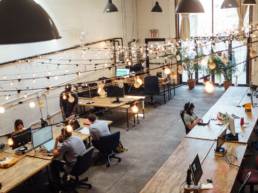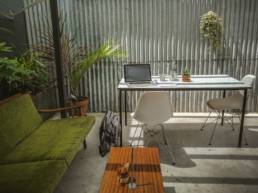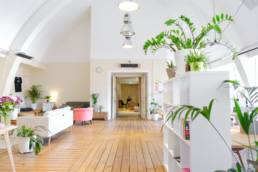5 top tips on creating a productive workspace.

1. Flourish your workspace with plants.
Plants can make a stuffy and stale workspace feel much more cheerful. There are proven benefits of having some greenery in the workspace, it has been shown that plants can help increase productivity and replenish focus. Objects like plants, photographs and other mementos in workspaces promote more psychological engagement than modern, empty spaces. Plants also encourage healthier indoor air, which has been proven to have some effect on cognitive functioning in the workspace.
In addition to an increase in focus and healthier indoor air, people tend to spend longer in places with biophilic designs, and happiness in a workspace tends to improve when natural features are installed. The theory of biophilia explains that humans have evolved an instinctual gravitation towards life and nature. It is thought that by looking at, or listening to sounds of nature, can help in reducing stress. It also allows us to think about things more clearly, be more adaptable and come up with more innovative ideas.

2. Establish some privacy.
Shared, open workspaces have been popular for a while now, and they do have their advantages. They promote communication and brainstorming ideas during meetings. Nevertheless, some recent studies have shown that they may not be the best for productivity altogether.
In the 2019 US workspace survey by Gensler, it was shown that “only a fraction of people would prefer working in a totally open or a totally private environment; over two-thirds (77 percent) consider environments that fall between these extremes to be ideal.” Workspaces with a good balance between both individual focus as well as collaboration have been proven to to be more innovative, creative and encouraging environments for workers.
Floor plans allowing not only open workspaces but also private rooms so they can concentrate encourages a balance for people in a workspace. An additional solution can incorporate rules such as when someone is wearing headphones to not disturb them, and to also include “quiet hours” within a workspace.
3. Providing the right tools, equipment and resources.
It is key to make sure an office is armed with the correct tools for its workers. Everyone in a workspace should have all the equipment they would need to perform their duties at work. In addition to this, members of the workspace should be able to swiftly deal with any queries or issues that they have without having to deal with complications.

4. Listen to Some Music
The Guardian wrote an article on the impact music has on concentration. It attests that music can actually encourage our capacity to pay attention, depending on the type of music that is listened to, so finding suitable music for optimum productivity can be hard as everyone has their own personal taste in music. It is important to make sure everyone in your workspace is happy with the music that is played.
5. Let in natural light.
Harsh, unnatural fluorescent lights are bad for people’s eyes, especially if they’re sat in front of a computer for most of their day. Fluorescent lighting has been linked to UV-related eye disease and melatonin suppression which can prevent sleep. A solution to this issue is more sunlight exposure. Noteworthy links have been discovered between daytime sunlight exposure and productivity. This is because sunlight affects our circadian rhythms as well as our vitamin D production. These two elements are tied to alertness and motivation.
Not every workspace is able to offer access to windows or persistent daylight. For desks that aren’t by a window should offer softer and more natural toned light bulbs as opposed to halogens. This is because lighting conditions that simulate daylight are able to improve alertness in comparison to electric lighting. An alternative to this could be LED lighting. A study has show that lensed-uplit surroundings are more suitable than overhead downlighting, this is because it leads to less eyestrain, promoting higher productivity. It is recommended to take outdoor breaks where possible.

